Grain-Scale Anisotropic Analysis of Steady-State Creep in Oligocrystalline SAC Solder Joints
Abstract
:1. Introduction
2. Multigrain TMM Specimen
3. Modeling Strategy
3.1. Anisotropic Single SAC Crystal: Crystal Viscoplasticity Model and Hill–Norton Continuum Model
3.2. Grain Boundary
4. Numerical Simulations
4.1. Calibration and Validation of Grain Boundary Properties on TMM Specimens
4.2. Grain-Scale Analysis of a Tri-Crystal BGA Joint
5. Conclusions
Author Contributions
Funding
Institutional Review Board Statement
Informed Consent Statement
Data Availability Statement
Acknowledgments
Conflicts of Interest
References
- Lau, J.H.; Li, M.; Qingqian, M.L.; Chen, T.; Xu, I.; Yong, Q.X.; Cheng, Z.; Fan, N.; Kuah, E.; Li, Z.; et al. Fan-out wafer-level packaging for heterogeneous integration. IEEE Trans. Compon. Packag. Manuf. Technol. 2018, 8, 1544–1560. [Google Scholar] [CrossRef]
- Rajmane, P.; Mirza, F.; Khan, H.; Agonafer, D. Chip package interaction study to analyze the mechanical integrity of a 3-D TSV package. In Proceedings of the ASME 2015 International Technical Conference and Exhibition on Packaging and Integration of Electronic and Photonic Microsystems collocated with the ASME 2015 13th International Conference on Nanochannels, Microchannels, and Minichannels, San Francisco, CA, USA, 6–9 July 2015; Volume 56895, p. V002T02A009. [Google Scholar]
- Zhang, Q. Isothermal Mechanical and Thermo-Mechanical Durability Characterization of Selected Lead-Free Solders. Ph.D. Thesis, University of Maryland, College Park, MD, USA, 2004. Available online: http://hdl.handle.net/1903/220 (accessed on 8 October 2020).
- Ma, H.; Suhling, J.C. A review of mechanical properties of lead-free solders for electronic packaging. J. Mater. Sci. 2009, 44, 1141–1158. [Google Scholar] [CrossRef]
- Cuddalorepatta, G.; Abhijit, D. Multi-scale modeling of the viscoplastic response of As-fabricated microscale Pb-free Sn3.0Ag0.5Cu solder interconnects. Acta Mater. 2010, 58, 5989–6001. [Google Scholar] [CrossRef]
- Mukherjee, S.; Zhou, B.; Dasgupta, A.; Bieler, T.R. Multiscale modeling of the anisotropic transient creep response of heterogeneous single crystal SnAgCu solder. Int. J. Plast. 2016, 78, 1–25. [Google Scholar] [CrossRef]
- Arfaei, B.; Mahin-Shirazi, S.; Joshi, S.; Anselm, M.; Borgesen, P.; Cotts, E.; Wilcox, J.; Coyle, R. Reliability and failure mechanism of solder joints in thermal cycling tests. In Proceedings of the IEEE 63rd Electronic Components and Technology Conference, Las Vegas, NV, USA, 28–31 May 2013; pp. 976–985. [Google Scholar]
- Daszki, A.A.; Gourlay, C.M. On the 3-D shape of interlaced regions in Sn-3Ag-0.5 Cu solder balls. J. Electron. Mater. 2021, 50, 808–817. [Google Scholar] [CrossRef]
- Zamiri, A.; Bieler, T.R.; Pourboghrat, F. Anisotropic crystal plasticity finite element modeling of the effect of crystal orientation and solder joint geometry on deformation after temperature change. J. Electron. Mater. 2009, 38, 231–240. [Google Scholar] [CrossRef]
- Roters, F.; Eisenlohr, P.; Bieler, T.R.; Raabe, D. Crystal Plasticity Finite Element Methods: In Materials Science and Engineering; John Wiley & Sons: Hoboken, NJ, USA, 2011. [Google Scholar]
- Subramanian, K.N.; Lee, J.G. Effect of anisotropy of tin on thermomechanical behavior of solder joints. J. Mater. Sci.: Mater. Electron. 2004, 15, 235–240. [Google Scholar] [CrossRef]
- Tian, Y.; Liu, W.; An, R.; Zhang, W.; Niu, L.; Wang, C. Effect of intermetallic compounds on fracture behaviors of Sn3.0Ag0.5Cu lead-free solder joints during in situ tensile test. J. Mater. Sci. Mater. Electron. 2012, 23, 136–147. [Google Scholar] [CrossRef]
- Le, V.-N.; Benabou, L.; Tao, Q.-B.; Etgens, V. Modeling of intergranular thermal fatigue cracking of a lead-free solder joint in a power electronic module. Int. J. Solids Struct. 2017, 106, 1–12. [Google Scholar] [CrossRef]
- Maleki, M.; Cugnoni, J.; Botsis, J. Microstructure-based modeling of the ageing effect on the deformation behavior of the eutectic micro-constituent in SnAgCu lead-free solder. Acta Mater. 2013, 61, 103–114. [Google Scholar] [CrossRef]
- Maleki, M.; Cugnoni, J.; Botsis, J. Multi-scale modeling of elasto-plastic response of SnAgCu lead-free solder alloys at different ageing conditions: Effect of microstructure evolution, particle size effects and interfacial failure. Mater. Sci. Eng. A 2016, 661, 132–144. [Google Scholar] [CrossRef]
- Xu, Y.; Gu, T.; Xian, J.; Giuliani, F.; Ben Britton, T.; Gourlay, C.M.; Dunne, F.P.E. Intermetallic size and morphology effects on creep rate of Sn-3Ag-0.5Cu solder. Int. J. Plast. 2021, 137, 102904. [Google Scholar] [CrossRef]
- Jiang, Q.; Dasgupta, A. Anisotropic steady-state creep behavior of Single-crystal β-Sn: A continuum constitutive model based on crystal viscoplasticity. Int. J. Plast. 2021, 140, 102975. [Google Scholar] [CrossRef]
- Haswell, P. Durability Assessment and Microstructural Observations of Selected Solder Alloys. Ph. D. Thesis, University of Maryland, College Park, MD, USA, 2001. [Google Scholar]
- Deshpande, A.; Jiang, Q.; Dasgupta, A. A joint-scale test specimen for tensile properties of solder alloys. In Proceedings of the 17th IEEE Intersociety Conference on Thermal and Thermomechanical Phenomena in Electronic Systems (ITherm), San Diego, CA, USA, 29 May–1 June 2018; pp. 1309–1313. [Google Scholar]
- Deshpande, A.; Jiang, Q.; Dasgupta, A.; Becker, U. Role of nominal stress state on cyclic fatigue durability of SAC305 grain-scale solder joints. J. Electron. Packag. 2021, 144, 031006. [Google Scholar] [CrossRef]
- Cuddalorepatta, G. Evolution of the Microstructure and Viscoplastic Behavior of Microscale SAC305 Solder Joints as a Function of Mechanical Fatigue Damage. Ph. D. Thesis, University of Maryland, College Park, MD, USA, 2010. Available online: http://hdl.handle.net/1903/10425 (accessed on 1 April 2020).
- Cuddalorepatta, G.; Williams, M.; Dasgupta, A. Viscoplastic creep response and microstructure of As-fabricated microscale Sn-3.0 Ag-0.5Cu solder interconnects. J. Electron. Mater. 2010, 39, 2292–2309. [Google Scholar] [CrossRef]
- Jiang, Q. Anisotropic Multi-scale Modeling for Steady-state Creep Behavior of Oligocrystalline SnAgCu (SAC) Solder Joints. Ph. D. Thesis, University of Maryland, College Park, MD, USA, 2021. Available online: https://drum.lib.umd.edu/handle/1903/27945 (accessed on 8 June 2020).
- Gavazzi, A.C.; Lagoudas, D.C. On the numerical evaluation of Eshelby’s tensor and its application to elastoplastic fibrous composites. Comput. Mech. 1990, 7, 13–19. [Google Scholar] [CrossRef]
- Zhou, B.; Bieler, T.R.; Lee, T.-K.; Liu, K.-C. Methodology for analyzing slip behavior in ball grid array lead-free solder joints after simple shear. J. Electron. Mater. 2009, 38, 2702. [Google Scholar] [CrossRef]
- Chu, S.N.G.; Li, J.C.M. Impression creep of β-tin single crystals. Mater. Sci. Eng. 1979, 39, 1–10. [Google Scholar] [CrossRef]
- Weertman, J. Compressional creep of tin single crystals. J. Appl. Phys. 1957, 28, 196–197. [Google Scholar] [CrossRef]
- Weertman, J.; Breen, J.E. Creep of tin single crystals. J. Appl. Phys. 1956, 27, 1189–1193. [Google Scholar] [CrossRef]
- Clegg, W.J.; Martin, J.W. Diffusion creep threshold in two-phase alloys. Met. Sci. 1982, 16, 65–72. [Google Scholar] [CrossRef]
- Lewis, A.C.; Van Heerden, D.; Eberl, C.; Hemker, K.J.; Weihs, T.P. Creep deformation mechanisms in fine-grained niobium. Acta Mater. 2008, 56, 3044–3052. [Google Scholar] [CrossRef]
- Maleki, M.; Cugnoni, J.; Botsis, J. Isothermal ageing of SnAgCu solder alloys: Three-dimensional morphometry analysis of microstructural evolution and its effects on mechanical response. J. Electron. Mater. 2014, 43, 1026–1042. [Google Scholar] [CrossRef] [Green Version]
- Spingarn, J.R.; Nix, W.D. A model for creep based on the climb of dislocations at grain boundaries. Acta Metall. 1979, 27, 171–177. [Google Scholar] [CrossRef]
- Crossman, F.W.; Ashby, M.F. The non-uniform flow of polycrystals by grain-boundary sliding accommodated by power-law creep. Acta Metall. 1975, 23, 425–440. [Google Scholar] [CrossRef]
- Telang, A.U.; Bieler, T.R. Characterization of microstructure and crystal orientation of the tin phase in single shear lap Sn–3.5 Ag solder joint specimens. Scr. Mater. 2005, 52, 1027–1031. [Google Scholar] [CrossRef]
- Smith, M. ABAQUS/Standard User’s Manual, Version 6.9; 2009. Available online: http://130.149.89.49:2080/v6.9/index.html (accessed on 5 November 2020).
- Spring, D.W.; Paulino, G.H. A growing library of three-dimensional cohesive elements for use in ABAQUS. Eng. Fract. Mech. 2014, 126, 190–216. [Google Scholar] [CrossRef]
- Motalab, M.A. A Constitutive Model for Lead Free Solder Including Aging Effects and Its Application to Microelectronic Packaging. Ph. D. Thesis, Auburn University, Auburn, AL, USA, 2013. Available online: http://hdl.handle.net/10415/3818 (accessed on 25 October 2019).
- Yang, J.-L.; Zhang, Z.; Schlarb, A.K.; Friedrich, K. On the characterization of tensile creep resistance of polyamide 66 nanocomposites. Part II: Modeling and prediction of long-term performance. Polymer 2006, 47, 6745–6758. [Google Scholar] [CrossRef]
- Fan, X.; Pei, M.; Bhatti, P.K. Effect of finite element modeling techniques on solder joint fatigue life prediction of flip-chip BGA packages. In Proceedings of the 56th Electronic Components and Technology Conference, San Diego, CA, USA, 30 May–2 June 2006. [Google Scholar]
- Darveaux, R. Effect of simulation methodology on solder joint crack growth correlation and fatigue life prediction. J. Electron. Packag. 2002, 124, 147–154. [Google Scholar] [CrossRef] [Green Version]

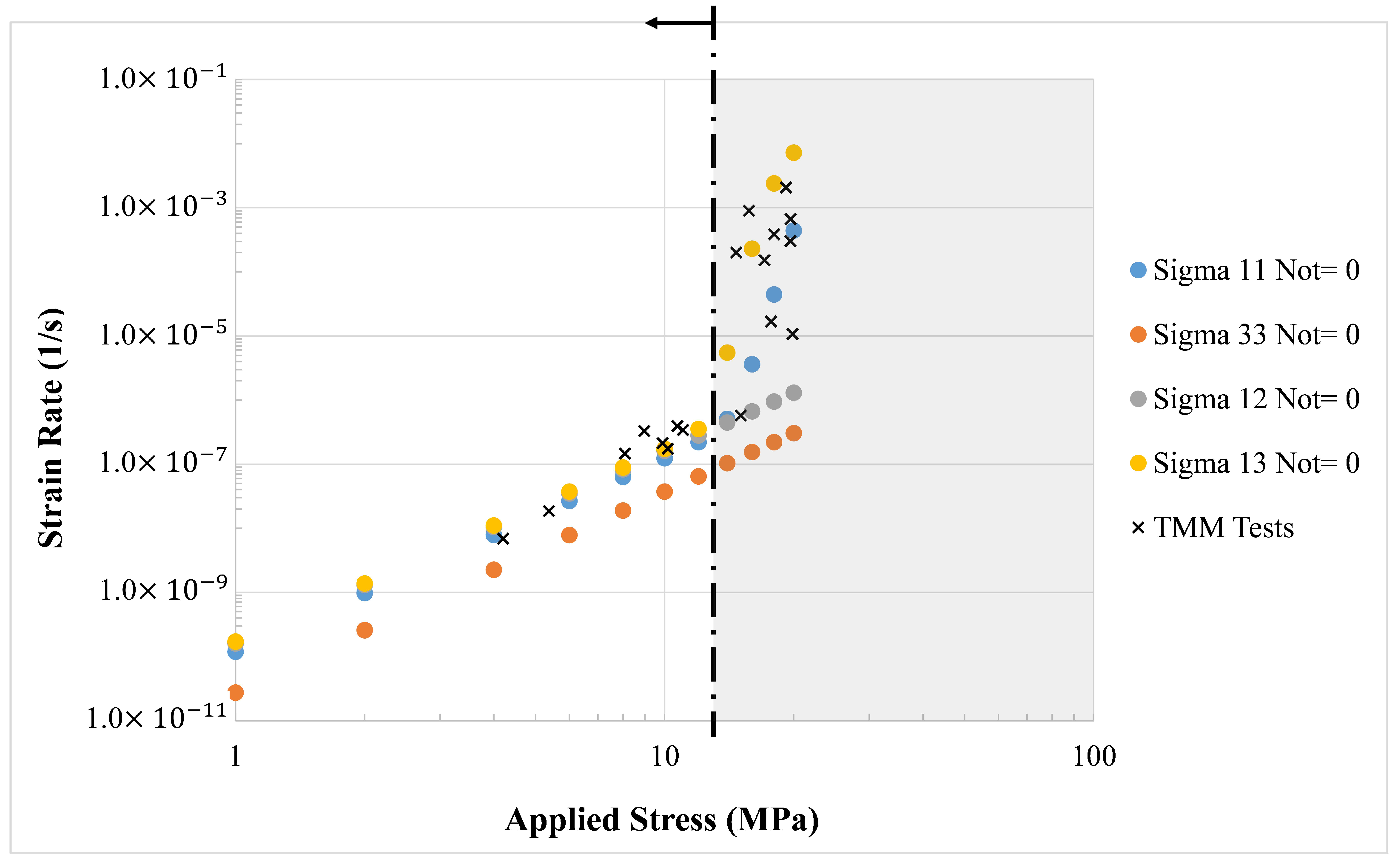
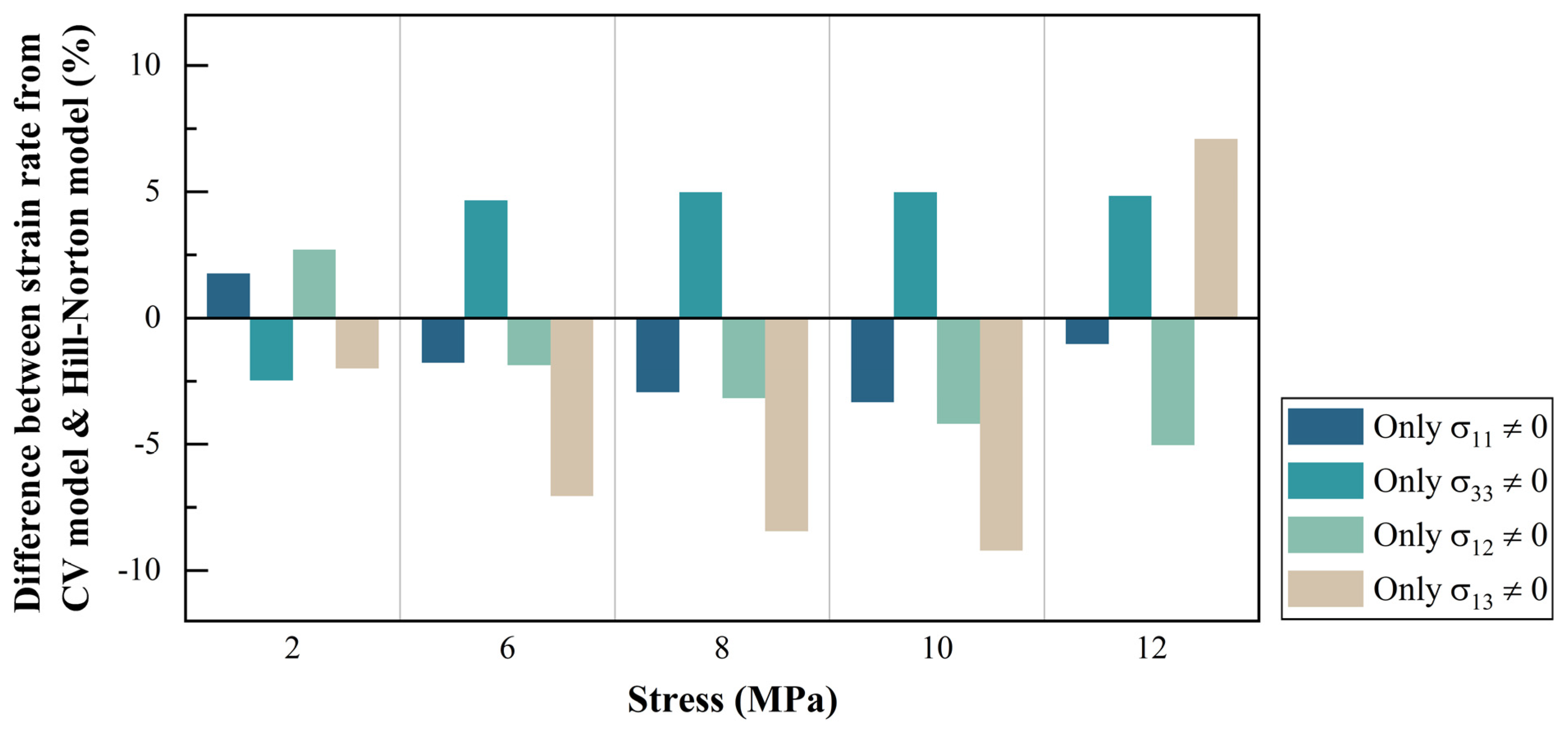
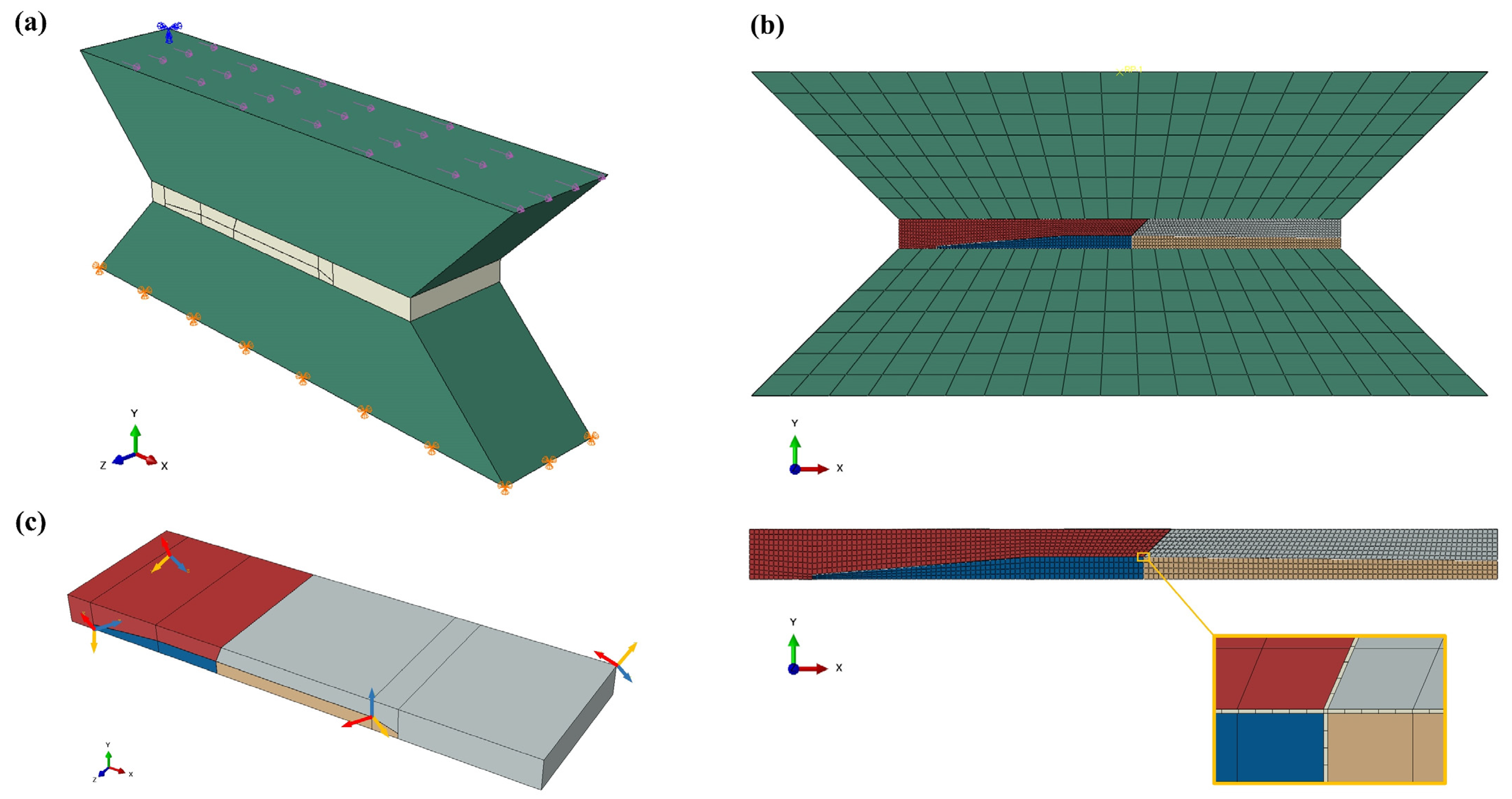
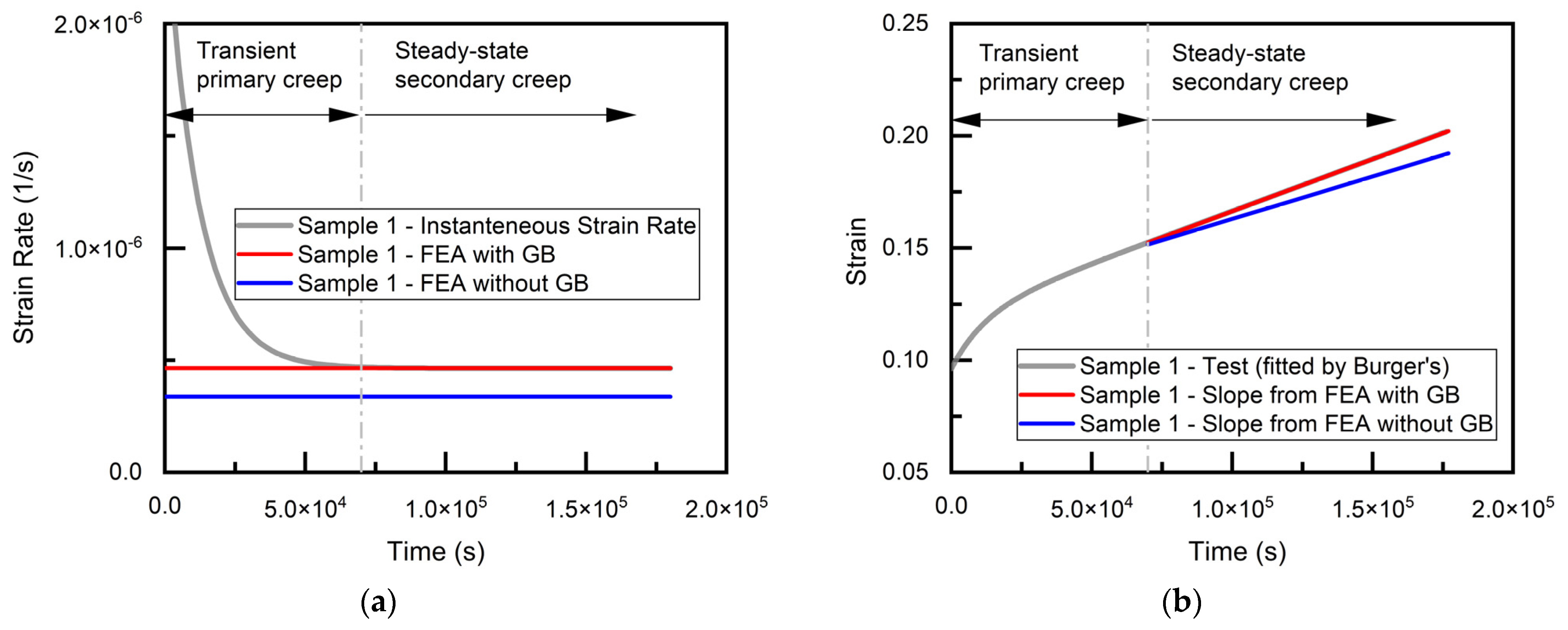
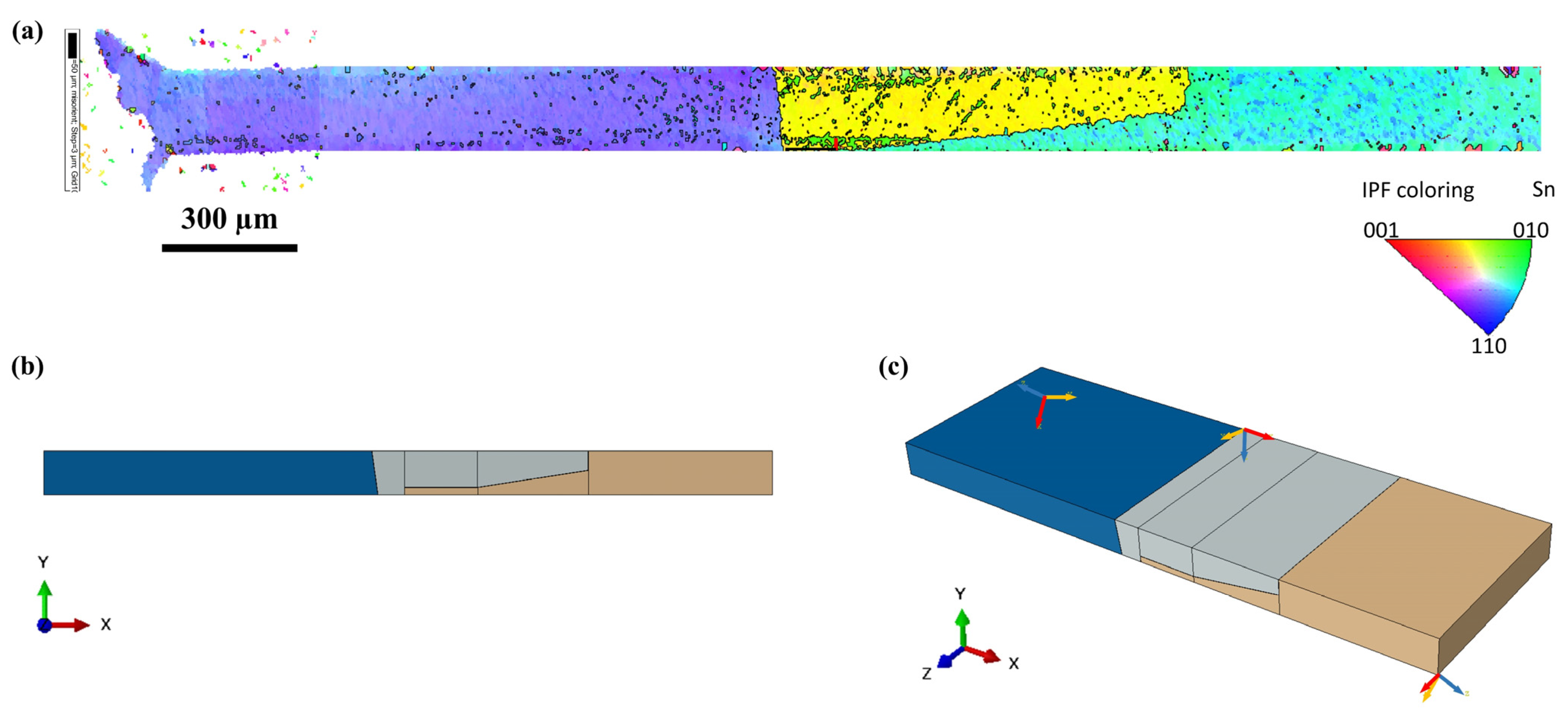
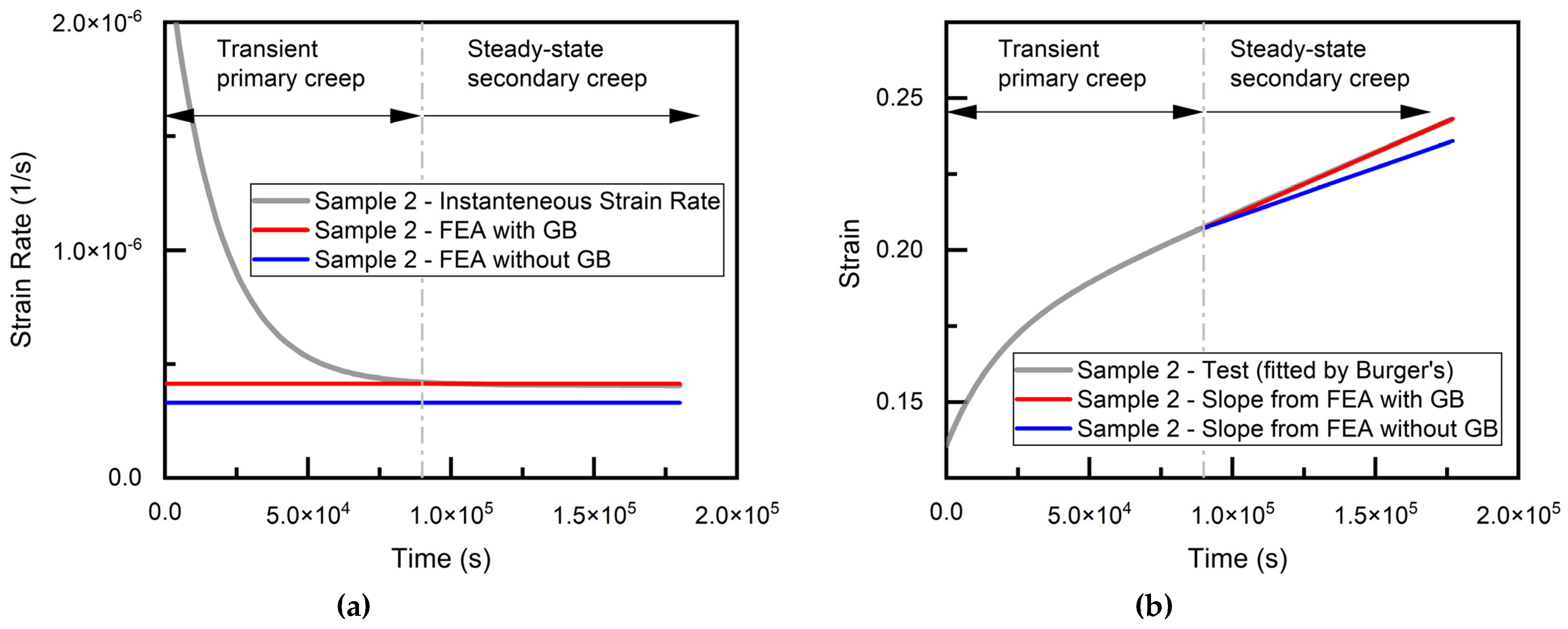

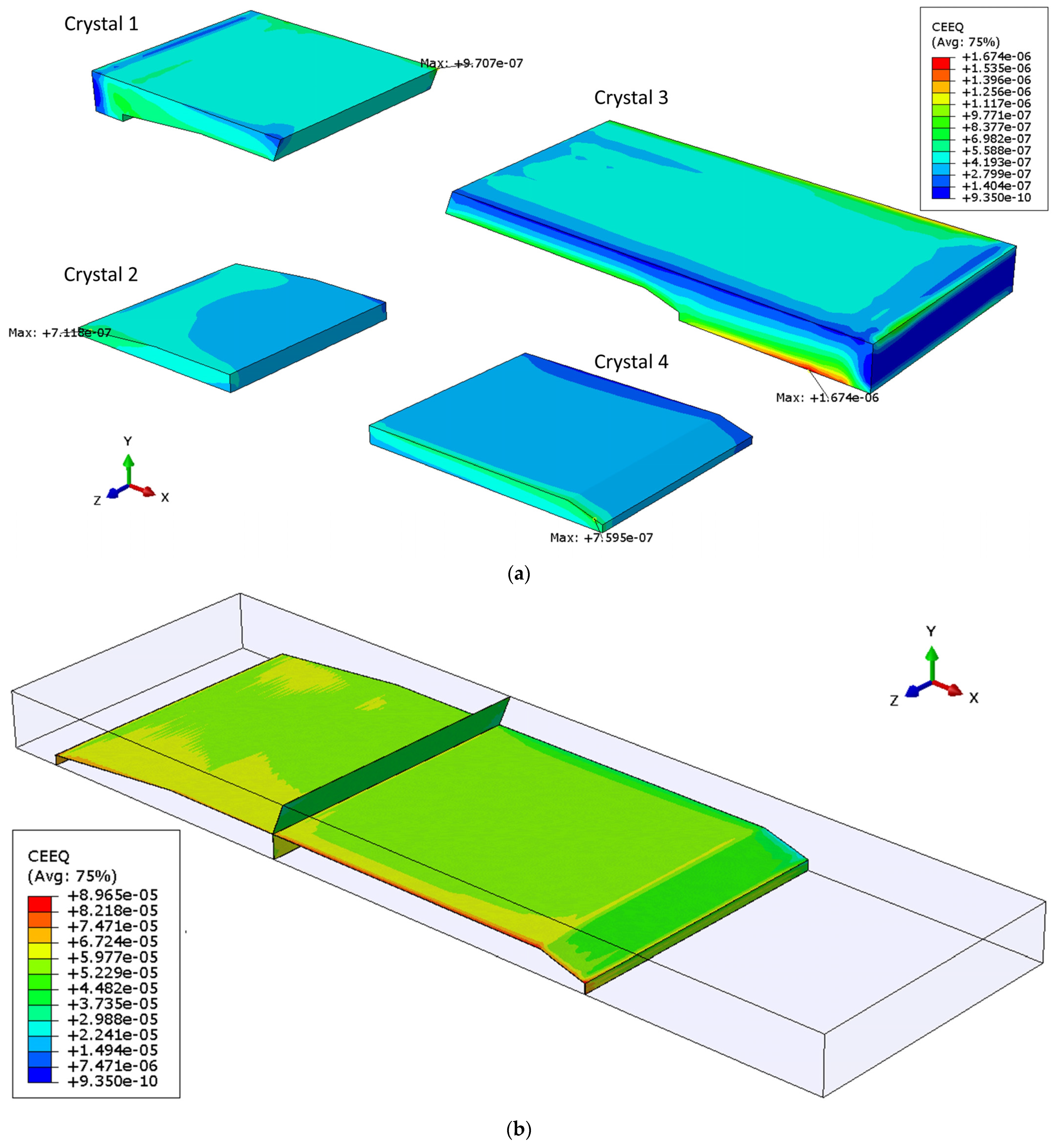
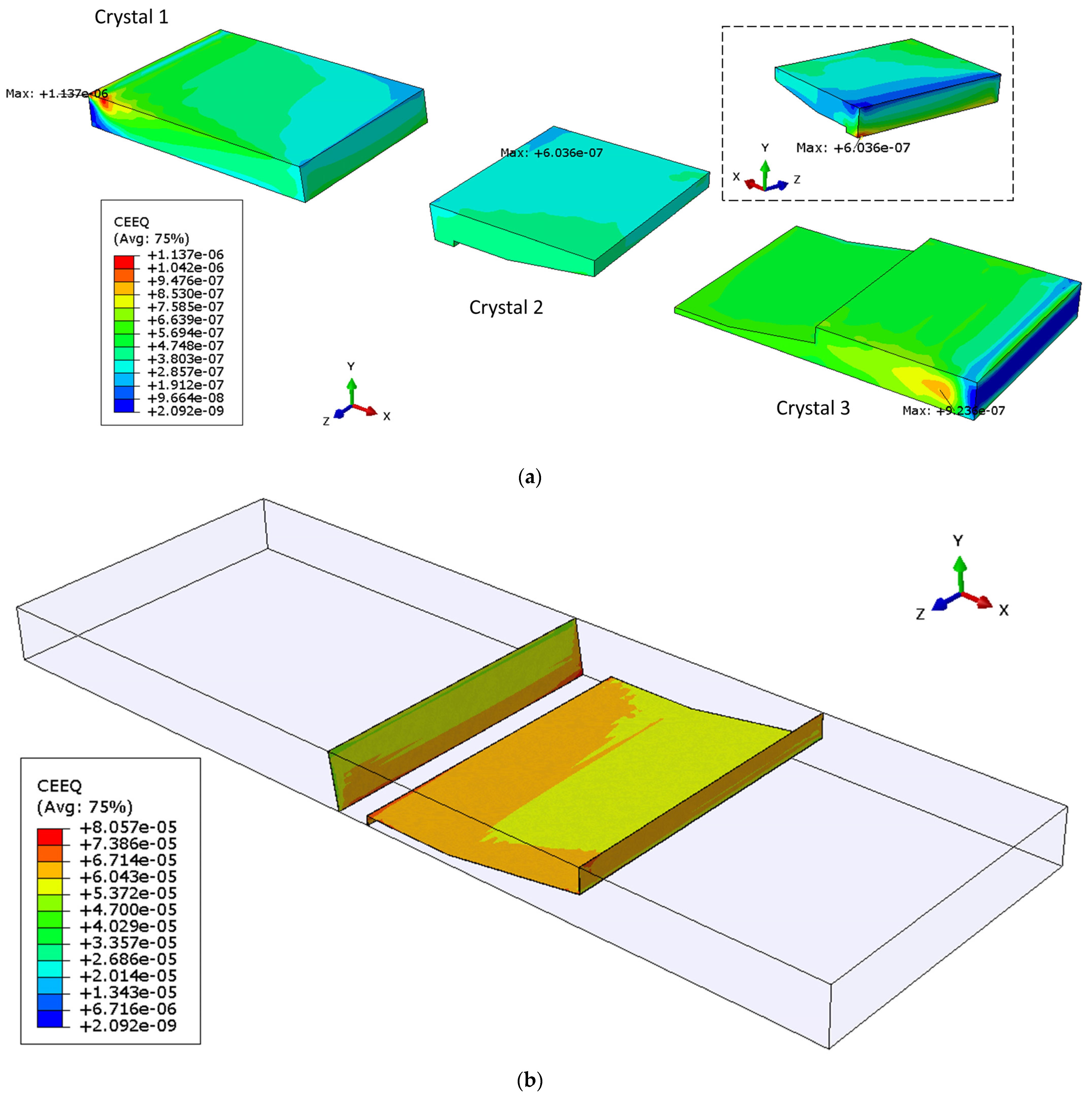
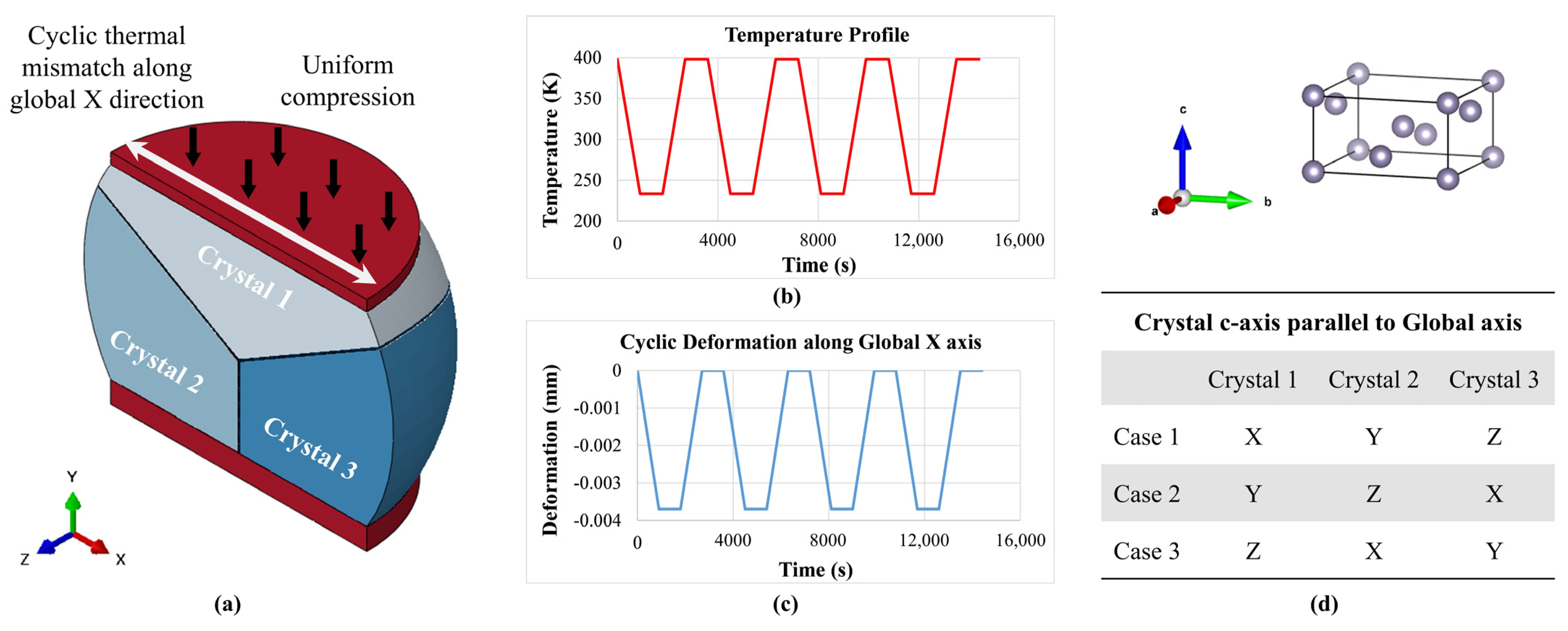

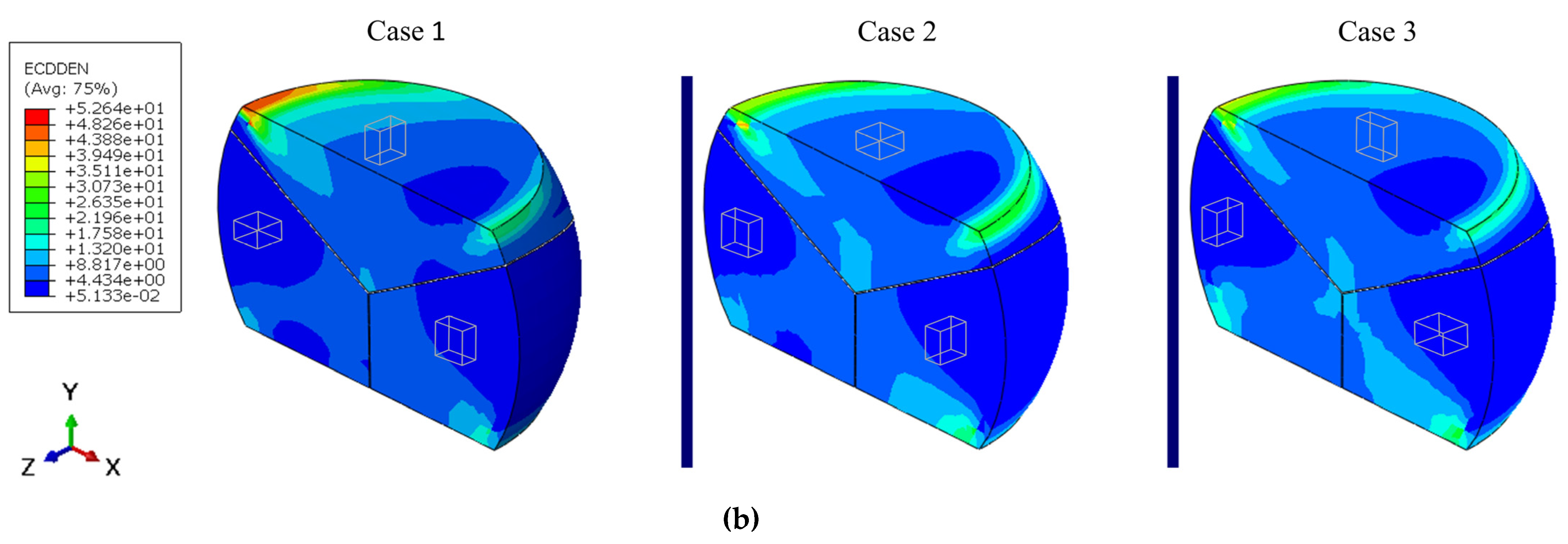

| 9.51 × 10−12 | 3.05 | 1 | 2.75 | 2.24 | 2.15 |
Publisher’s Note: MDPI stays neutral with regard to jurisdictional claims in published maps and institutional affiliations. |
© 2021 by the authors. Licensee MDPI, Basel, Switzerland. This article is an open access article distributed under the terms and conditions of the Creative Commons Attribution (CC BY) license (https://creativecommons.org/licenses/by/4.0/).
Share and Cite
Jiang, Q.; Deshpande, A.N.; Dasgupta, A. Grain-Scale Anisotropic Analysis of Steady-State Creep in Oligocrystalline SAC Solder Joints. Materials 2021, 14, 5973. https://doi.org/10.3390/ma14205973
Jiang Q, Deshpande AN, Dasgupta A. Grain-Scale Anisotropic Analysis of Steady-State Creep in Oligocrystalline SAC Solder Joints. Materials. 2021; 14(20):5973. https://doi.org/10.3390/ma14205973
Chicago/Turabian StyleJiang, Qian, Abhishek Nitin Deshpande, and Abhijit Dasgupta. 2021. "Grain-Scale Anisotropic Analysis of Steady-State Creep in Oligocrystalline SAC Solder Joints" Materials 14, no. 20: 5973. https://doi.org/10.3390/ma14205973




